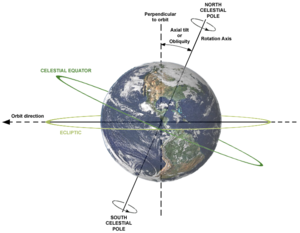Climate Change/Science/Sun-Earth System
In Sun's Influence on Earth, a simplified view of the Sun-Earth system has been used. The results are correct, and show how simple physical principles directly inform us about some of the most important aspects ofthis view is inadequate; this will become especially clear in the discussion of paleoclimate (ancient climate) and ice ages. Here let us review a few important aspects of the system to set the stage for later discussions.
Perhaps the most profound influence on the Earth-Sun system is the geometry involved. The most basic part of this geometry is the orbit of Earth around the sun, which is governed by the gravitational attraction between the two bodies. Kepler[1] showed that orbits are ellipses, rather than perfect circles. Earth's orbit is slightly elliptical, with an eccentricity of just 0.01671 [2]; even though this value is small, it has important consequences. The perihelion, or smallest distance from the sun, occurs during the northern hemisphere's winter and is about , and aphelion, the most distant point from the sun, is during the northern hemisphere's summer and is about This difference does not cause Earth's seasons, but can influence the severity of seasons (discussed in the paleoclimate section) and does introduce small variations to the annual incoming solar radiation ("insolation") as there are very slow variations in the eccentricity.
A second important effect to consider is the tilt of Earth's spin axis with respect to the ecliptic plane, which is basically the average plane of Earth's orbit around the sun. The angle between the spin axis and the perpendicular to the ecliptic plane is called Earth's obliquity, and is currently about 23.4 degrees. This angle is the primary reason for seasons on Earth, for as the planet traverses its orbit, the amount of insolation at points on the surface slowly change, with winter occurring when the pole faces away from the sun and summer when the pole faces toward the sun. Seasons are more extreme with larger obliquity, and high latitudes (e.g. Antarctica) experience more extreme changes in insolation than the tropics, leading to more pronounced season. Earth's obliquity slowly changes in time, which has important consequences for very long-term climate change.

A third important part of the Earth-sun geometry is called precession, and is actually the combination of parameters. Precession is the slow variation of direction of the spin axis, and is affected by both a turning of the spin axis and a slow change in the shape of Earth's orbit. For the contemporary climate, the precession only matters because it determines the relative position of the poles to the sun during Earth's orbit. There are important consequences for long-term climate change, though, which will be discussed later.
The geometry of the Earth-sun system is a large part of the astronomical basis for Earth's climate. Other astronomical factors that are important include the evolution of the solar system and the sun itself, as well as electromagnetic phenomena (e.g. the solar wind). These topics are well worth studying, even in the context of climate, but they are beyond the scope of this book, as they bear little relevance on contemporary climate change.
References
[edit | edit source]- ^ Eccentricity is defined for all conic sections, and is a relationship between the semimajor (a) and semiminor (b) axes. It can be determined by
- For a perfect circle a = b, so the eccentricity is zero, for an ellipse a > b, and the eccentricity is bounded See also [Wolfram MathWorld].




